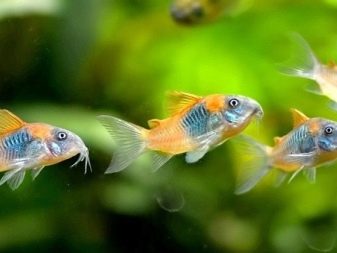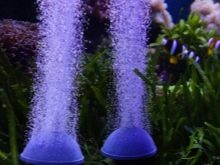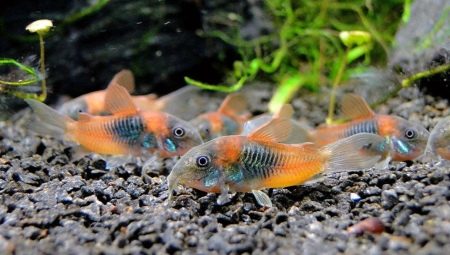Aquarium catfish of the corridor belongs to the shell species. In total, more than 150 varieties of this fish are known. One of the most popular species in the world of aquariums is considered corridor Venezuela - small cute fish with a friendly character and not requiring difficult conditions.

Usually, catfish live at home for 10-12 years, but with proper care, the corridor can please its owner even up to 15-20 years.
Description
In nature, the corridor of Venezuela lives in the waters of South America. Usually the size of an adult is limited to 6.5-7.5 cm. Fish can have different colors. If this is an orange color, the fish’s body is painted in a rusty-orange bronze color with a dark spot casting a turquoise hue that covers the “shoulders” zone. On the back of the head there is a red-brown spot.
Another common color is black. This fish is presented in a dark brown color, it has a light gray abdomen, dark and red-brown fins.


There are some gender differences in appearance. So, at puberty, females are usually more massive, larger, more plump, they have a rounded abdomen, while males look smaller and more elegant. The fin on the back of the male catfish is sharpened towards the end, and in the female it is rounded. An interesting feature of catfish is the ability to breathe in the intestines. When there is a deficiency of oxygen in a body of water, the fish rises to the surface, where it breathes atmospheric air.

In this regard, corridors when kept in the aquarium should have constant access to the surface.
Maintenance and care
In the content of the corridor, it is important to pay attention to the soil, since this is still a bottom animal. You can use dark sand or fine gravel. Make sure the ground no sharp particlesthat could injure the pet.
Choose vegetation mosses, ferns, shrubby aquarium plants. Inhabited at the bottom, Venezuelans love to dig in the ground, so they can easily uproot a fragile plant. In this regard, choose to land aquarium crops with strong rhizomes.

It is recommended to start 5-8 catfish at once in one aquarium. For such a group, an aquarium of 50-60 liters is enough. Not a large amount of water is important for fish, but space for studying the bottom. Therefore, it is necessary to select a tank that is elongated in length, and not in height, so that all the fish have enough space at the bottom. Give up powerful lighting.

Catfish are most active in twilight and do not like bright light.
You can create a shadow using floating plants. Use driftwood and caves as decorations, but do not overdo their number - each catfish should have enough space for swarming at the bottom. Do not forget to equip the aquarium with an aerator and filter. Clean the filter regularly and choose a machine that catfish cannot get into. For some types of aquarium catfish, this tendency is observed, leading to the death of the pet.



Favorable temperature for keeping the Venezuelan corridor is 22-26 degrees, acidity is 5.5–8.0 pH, hardness is 5-18 dH. Produce weekly 30% water changepour in fresh, settled during the day water. Use the siphon regularly to clean the ground, but be careful not to injure the catfish who is gape at the bottom. Make sure that the ground does not contain sharp stones or broken pieces of decoration - corners can damage the mouth or antennae of pets.


In general, corridors are rarely ill, and with proper care their immunity is strengthened even more, therefore they are not prone to disease. However, it is important to include preventative measures in the form of adding kitchen salt to the aquarium. This method is often used in the treatment of some aquarium inhabitants, and if corridors are found near sick individuals, they should be put off for the duration of treatment.

Feeding
Venezuelans are omnivorous catfish. At home, it is recommended to feed them with sinking dry granules and tablets. Pets will pick up the leftover food from the bottom, thereby cleaning the aquarium.
You can feed these fish alive whole or chopped worms. You can offer live or frozen food - bloodworms, artemia, daphnia, tubule, cyclops are suitable. Experienced breeders recommend feeding the corridors several times a day dosed - It is preferable to offer a bulky portion than once a day.

Compatibility
Typically, the corridor is usually settled with fish of the same size as himself. Good catfish get along with small peace-loving fish, for example, guppies, discus, pecilia, mollies, scalars, swordfish, zebrafish, cockerels. Neighborhood with barbs, shrimp, eels is not always possible. The forbidden neighbors are Koi carps, goldfish, astronotuses, African and South American cichlids, large predatory fish.





Breeding
For breeding, producers from the age of 1.5 years are selected. Usually 2-3 males are recommended per female. You can breed catfish in groups, for example, take 2-3 females and 4-6 males. At first, male and female individuals are kept separately for a week - this is necessary in order to warm up sexual interest in each other. During this period, future parents are plentifully and variably fed.
At this time, you can prepare spawning ground. To do this, equip a separate aquarium with a filter, an aerator, plant deciduous plants, and set decorations.After planting individuals in a tank, the water in the spawning is changed as often as possible - this process stimulates the spawning of fish.
First, the males pursue their beloved, then one of the “suitors” turns sideways and releases a sperm ring. The female at this moment lays a few eggs, after which it passes into this ring and goes to throw eggs on plants and hard surfaces.

About 1 egg is obtained at one time, however, the procedure is repeated again and sometimes continues for 3 days. During this period, it is important to feed the fish well so that they do not eat their own offspring. On average, 800 eggs are possible for one spawning. To save the cubs, adult individuals are planted. The fry appear in about 10 days, they begin to swim on the 5-7th day.

The baby’s starting food can be “live dust”, then the cubs are transferred to artemia, and already at the age of one month the fry are ready to move to a common aquarium.
About the features of this aquarium fish, see below.










